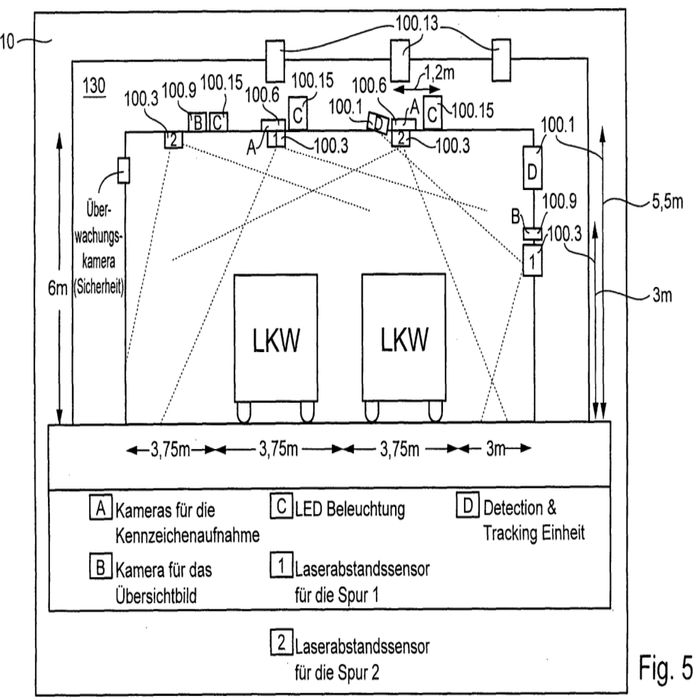The EPO considered determining whether a suspicious vehicle needs to be stopped to detect a toll offence is a legal requirement and thus non-technical. Here are the practical takeaways from the decision T 0595/16 (Kontrollbedüftiges Fahrzeug/TOLLCOLLECT) of 14.9.2020 of Technical Board of Appeal 3.5.05:
Key takeaways
Assigning vehicles to different groups based on specific criteria in order to decide whether a vehicle has to be checked manually is a business-related method and thus not technical.
The invention
This European patent application underlying the present decision relates to a control method for road toll collection using a control system. Every vehicle on every road section that is monitored by the system is to be checked by collecting usable vehicle information. Based on these information, it is decided whether suspicious vehicles are stopped and checked manually by inspection staff (cf. WO 02/061690 A1, pages 1-3).

Fig. 5 of WO 02/061690 A1
Here is how the invention was defined in claim 1:
Claim 1 (main request) - translated from German into English by the author of this post
Control method for road toll collection with a stationary control system (10) with several collection devices for vehicle information and with a trigger device for the timely activation of the collection devices, wherein the individual collection devices are activated at times, to which the spatial arrangement of a vehicle and the detection device detecting the respective vehicle information is optimal, wherein the various vehicle information of the vehicle detected by the detection devices spatially and temporally separated by the detection devices are assigned by the stationary control system (10) to the vehicle and a reference time, and the stationary control system (10) retrieves data from a vehicle device of the vehicle,
wherein the stationary control system (10) receives from a control center (20) data on blacklist updates with the data of blocked vehicle devices or survey cards, whitelist entries with all valid entries for the section to be checked and time of check, tariff data, classification data, data key updates for an encrypted data transmission, and software updates,
characterized in that
based on the vehicle information acquired by means of the acquisition devices, the data received from the control center (20), the data retrieved from the vehicle device of the vehicle, and based on the following case groups:
– non-toll vehicle,
– recognized good payer,
– vehicle registration number not recognized,
– doubts about the toll obligation of the vehicle,
– doubts as to the fulfilment of the toll obligation,
– detected false payer,
– recognized non-payer,
– Wrong license plate,
– suspicion of manipulation of the vehicle device, and
– vehicle device or survey card blocked,
the stationary control system (10) automatically determines whether the vehicle is in need of control, whereby the need for control of the vehicle is defined by the presence of a pre-definable combination of case groups, and
– in the event of a determined need for control of the vehicle, vehicle information about the vehicle is transmitted to a control point (40), wherein the transmitted control data of the vehicle are displayed to a control person at the control point (40), wherein vehicles for which a need for control has been determined can be diverted from flowing traffic by the control person.
Is it patentable?
The first-instance examining division rejected the application due to lack of inventive step in light of prior art document D4. Independent claim 1 of the rejected application differs from the teaching of D4 in that control data of a vehicle subject to checks are not transmitted to a control center but to a control point. According to the application, a control point is a checkpoint where control staff performs manual inspections of vehicles. However, the first-instance examining division considered this distinguishing feature to be non-technical and argued that the necessity of stopping a suspicious vehicle to conduct a further manual control is considered a legal requirement, but not a technical one. Hence, the distinguishing feature was not considered for the assessment of inventive step (cf. point 1.4 of the appeal decision).
During appeal stage, the applicant further argued that assigning the vehicles to be checked into different case groups as specified by claim 1 would be technical (cf. point 1.5 of the appeal decision). In more detail, it would be technical to change the number of vehicles that need to be checked by assigning them to different groups which are then used to decide whether a vehicle is manually checked or not.
However, the board in charge did not follow these arguments and argued that assigning vehicles to different groups is a business-related method to control the number of vehicles to be checked, as for example outlined in the description in the sentence bridging pages 30 and 31. Hence, also the feature of claim 1 referring to the case groups is considered non-technical and thus not relevant for assessing inventive step.
As a result, the board in charge came to the conclusion that D4 renders-obvious the claimed subject-matter and dismissed the appeal.
The content of this article is intended to provide a general guide to the subject matter. Specialist advice should be sought about your specific circumstances.

